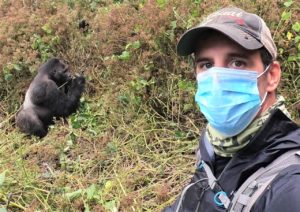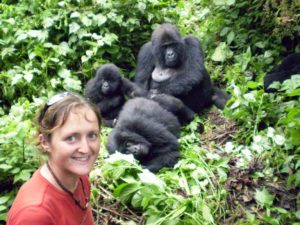Gorilla Trekking after Covid-19 in Uganda, Rwanda and Congo
Gorilla trekking after COVID-19 in Uganda, Rwanda and Congo: Gorilla trekking or gorilla tourism in Uganda, Rwanda and Congo is an exciting opportunity for tourists to see mountain gorillas while in the wild. Though the outbreak of coronavirus caused a standstill for gorilla tourism activities in Uganda, Rwanda and Congo, measures or standard operating procedures have been put in place for tourists to observe and interestingly, gorilla trekking safaris have resumed.
Is coronavirus a threat to gorillas?
 While no study/research has been conducted regarding the threat of corona virus to gorillas and other primates, there is adequate information. When tracking gorillas, tourists get close to these massive apes but guides the overall gorilla trekking activity is the gorilla tracking rules and regulations.
While no study/research has been conducted regarding the threat of corona virus to gorillas and other primates, there is adequate information. When tracking gorillas, tourists get close to these massive apes but guides the overall gorilla trekking activity is the gorilla tracking rules and regulations.
On the actual gorilla trekking, much emphasis are put on measures such as gorilla trekking rules or standard operating procedures aimed at preventing the wide spread of infectious diseases such as COVID-19. Looking at how COVID-19 spreads and its symptoms, there is a clear indication that COVID would be a threat to mountain gorillas and other primates. This is one reason why gorilla tourism and other primate safaris were suspended in Uganda, Rwanda and Congo plus other destinations.
SOPs- Standard Operating Procedures for gorilla trekking
- Handwashing & sanitizing is a must do while on gorilla trekking safari in Uganda, Rwanda and Congo.
- Screening of body temperatures is mandatory before you are allowed to participate in gorilla trekking in Uganda, Rwanda and Congo.
- Small groups of about 8 visitors after they allocation of gorilla groups for trekking shall be allowed to attend briefing.
- Wearing of face masks is an essential requirement and the mask must cover the nose and mouth properly.
- Each gorilla group is trekked by 8 tourists per day in Uganda, Rwanda and Congo.
- Tourists with illnesses or signs of flu, diarrhea etc won’t be permitted to go track gorillas.
- The park guide must ensure social distancing of 2 meters among tourists is observed where need be.
- Frequent breaks shall be made to let visitors breathe in fresh air considering the effects reported about wearing face masks for long hours.
- Visitors on gorilla trekking in Uganda, Rwanda and Congo are advised to carry light gear/equipment to limit the need for porters.
Gorilla trekking in Uganda
Where is gorilla trekking conducted in Uganda?
There are only 2 places to visit in Uganda to enjoy gorilla trekking after COVID and they include Bwindi Impenetrable National Park and Mgahinga Gorilla National Parks, all these National Park are in the Southwestern side of the country. These are accessible from Kampala or Kigali- from Kampala, Bwindi and Mgahinga National Park are about 9 hours’ drive and 3-4 hours from Kigali.
 Bwindi Impenetrable National Park shelters a vast impenetrable forest where 459 mountain gorillas all live out of the remaining world’s 1063 in the world. Bwindi was established in 1991 and the main reason was to protect a section of endangered mountain gorillas. In 1994, Bwindi Impenetrable National Park was designated as a UNESCO World Heritage Site protecting over 20 habituated gorilla families in its 4 regions- Nkuringo, Rushaga in the South; Ruhija region in the East and Buhoma in the North. It is in Bwindi where you can enjoy both gorilla trekking and gorilla habituation experience.
Bwindi Impenetrable National Park shelters a vast impenetrable forest where 459 mountain gorillas all live out of the remaining world’s 1063 in the world. Bwindi was established in 1991 and the main reason was to protect a section of endangered mountain gorillas. In 1994, Bwindi Impenetrable National Park was designated as a UNESCO World Heritage Site protecting over 20 habituated gorilla families in its 4 regions- Nkuringo, Rushaga in the South; Ruhija region in the East and Buhoma in the North. It is in Bwindi where you can enjoy both gorilla trekking and gorilla habituation experience.
Mgahinga Gorilla National Park lies in Kisoro District and makes up part of the extensive Virunga Conservation Area. Unlike Bwindi or other gorilla safari parks, Mgahinga Gorilla National Park hosts only one habituated gorilla family group- Nyakagezi gorilla family. It is in Mgahinga where you can also encounter golden monkeys while on Uganda safaris and you can undertake golden monkey tracking or golden monkey habituation experience.
Gorilla permits Uganda and how to book
Gorilla permits are a must have if you plan to embark on gorilla trekking after COVID-19 in Uganda. There are 3 visitor categories- the Foreign Non Residents who pay USD700; Foreign Residents USD600 and East Africa citizens UGX 250,000. All interested visitors in gorilla trekking in Uganda post COVID can book their gorilla permits via a registered tour operator on ground or directly with reservation team from Uganda Wildlife Authority (UWA).
Gorilla trekking in Rwanda
Gorilla safaris in Rwanda post COVID are carried out in only Volcanoes National Park in the Northwest. Volcanoes National Park also lies within the Virunga Ranges region and occupies 160sq.kms, protecting 13 gorilla families set for gorilla tourism. Gorilla permits in Rwanda should be booked if you are to be allowed to go track gorillas and each gorilla permit costs USD1500. The Rwanda gorilla permits can be booked in two ways- via a reliable tour operator on ground or directly with team from Rwanda Development Board (RDB).
Gorilla trekking in Congo
Gorilla trekking in Congo offers a great opportunity to tourists to encounter both mountain gorillas and Eastern lowland gorillas in their natural habitat. Mountain gorillas in Congo live in only Virunga National Park which is part of the Virunga Conservation Area. Virunga NP has 8 habituated gorilla families that are open for gorilla trekking while Eastern Lowland gorillas are trekked in Kahuzi-Biega National Park. Gorilla permits for both Parks in Congo cost USD450 per person.
What to carry for gorilla trekking after COVID?
If you plan to be part of gorilla trekking after COVID, the important items to carry include face masks, insect repellents, camera with no flashlight, waterproof hiking boots, long sleeved shirts, daypack, gardening gloves, first aid kit, trousers, snacks, bottled water and others.
Best time to go for gorilla trekking after COVID-19 in Uganda, Rwanda and Congo
Trekking gorillas in Uganda, Rwanda and Congo is possible at any time, month of the year. But June, July, August, September and December, January, February are considered to be the best months of the year when it comes to gorilla trekking. This is due to low or no rains with National Parks kept relatively drier making it easier to navigate through the forest and steep slopes when searching for gorillas.

